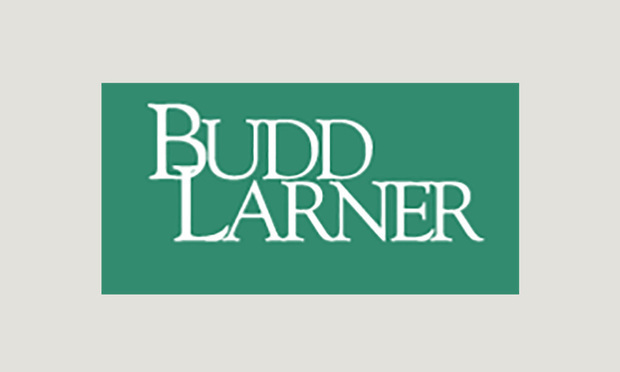Budd Larner Expected to Close This Summer, Sources Say
While the firm had as many as 75 attorneys about four years ago, Budd Larner's head count has dwindled to about 31 lawyers on its website today.
May 28, 2019 at 03:59 PM
4 minute read
 Budd Larner logo. Courtesy image.
Budd Larner logo. Courtesy image.
Rocked by significant shareholder defections, Budd Larner is expected to close this summer, according to six people close to the prominent New Jersey law firm.
The Short Hills-based firm has made no public announcement of the closing plans. Firm leaders stated last month that they were "evaluating next steps for the firm."
The firm's remaining executive committee members, Susan Reach Winters and Peter Frazza, did not return messages seeking comment last week and Tuesday. The firm's chief operating officer, Mitchell Rait, declined to comment May 22 and did not return subsequent email messages.
Budd Larner, now in its 85th year, had as many as 75 lawyers about four years ago. But in recent years, the firm's head count has dwindled and it has seen several rainmakers exit just in the last year. The firm currently lists 31 lawyers on its website and offices in four locations: Short Hills and Cherry Hill, New Jersey, as well as New York and Philadelphia.
Just last month, the firm lost at least 18 lawyers, including two members of its executive committee, to other firms.
The recent exits include executive committee member Andrew Miller, who led a group of 15 intellectual property lawyers to the Madison office of Windels Marx Lane & Mittendorf, and another executive committee member, James Fitzsimmons, who joined Drinker Biddle & Reath.
After those exits, Frazza and Winters said in a statement that they were "evaluating next steps for the firm."
The sources who told ALM about the firm's closing plans all spoke on condition of anonymity as they were not authorized to discuss it. The exact timing of the closing is unclear, but all sources pointed to this summer.
Shareholder exits haven't been Budd Larner's only problems in the last year. Its former chief technology officer, Rocco Romeo, was charged by federal prosecutors in late January for allegedly seeking to defraud the firm. Manhattan federal prosecutors allege Romeo and a co-defendant, Jacqueline Galler, created a shell company to bill nearly $900,000 of expenses to Romeo's employer using false charges and invoices over three years.
Prosecutors say the two used the funds to pay personal expenses. Romeo and Galler were charged with four criminal counts, including wire fraud and money laundering-related charges.
(A judge on May 29 dismissed the charges against Galler without prejudice.)
Shortly after Romeo was arrested, Budd Larner filed a civil RICO lawsuit against Romeo and Galler. "The firm suffered significant financial losses as a result of defendants' ongoing pattern of theft, unlawful receipt and conversion of the firm's money," Budd Larner said in its Feb. 25 lawsuit, claiming losses of at least $902,147. (Galler has filed a cross-claim against Romeo in that case, alleging the alleged transactions were performed by Romeo without her knowledge or consent.)
Budd Larner's attorneys in the RICO case, shareholder Philip Clarke Chronakis and associate Adam Hoffman, did not respond to a message seeking comment on Romeo or the firm's closing plans.
Romeo's defense attorney, Jason Ser, of Federal Defenders of New York, did not respond to a request for comment. Galler's attorneys, Benjamin Ostrer and David Darwin of Ostrer & Associates, also did not respond to a message.
The firm that would become known simply as Budd Larner in recent years started in 1934 as a small firm in Newark and grew to roughly 110 lawyers in the 1980s, though its head count would fluctuate over the years with rounds of defections and new hires.
The firm transformed from an insurance defense firm to one offering a range of services, and came to be fueled by a national mass toxic tort litigation practice. Budd Larner became known for its involvement representing plaintiffs in the 1980s and 1990s in civil litigation against tobacco companies over their products' link to cancer in users.
Editor's Note: This article has been updated to reflect that a judge dismissed the charges against Jacqueline Galler on May 29, 2019, a day after this article was published.
This content has been archived. It is available through our partners, LexisNexis® and Bloomberg Law.
To view this content, please continue to their sites.
Not a Lexis Subscriber?
Subscribe Now
Not a Bloomberg Law Subscriber?
Subscribe Now
NOT FOR REPRINT
© 2025 ALM Global, LLC, All Rights Reserved. Request academic re-use from www.copyright.com. All other uses, submit a request to [email protected]. For more information visit Asset & Logo Licensing.
You Might Like
View All
Neighboring States Have Either Passed or Proposed Climate Superfund Laws—Is Pennsylvania Next?
7 minute read
An Overview of Proposed Changes to the Federal Rules of Procedure Relating to the Expansion of Remote Trial Testimony
15 minute readTrending Stories
Who Got The Work
J. Brugh Lower of Gibbons has entered an appearance for industrial equipment supplier Devco Corporation in a pending trademark infringement lawsuit. The suit, accusing the defendant of selling knock-off Graco products, was filed Dec. 18 in New Jersey District Court by Rivkin Radler on behalf of Graco Inc. and Graco Minnesota. The case, assigned to U.S. District Judge Zahid N. Quraishi, is 3:24-cv-11294, Graco Inc. et al v. Devco Corporation.
Who Got The Work
Rebecca Maller-Stein and Kent A. Yalowitz of Arnold & Porter Kaye Scholer have entered their appearances for Hanaco Venture Capital and its executives, Lior Prosor and David Frankel, in a pending securities lawsuit. The action, filed on Dec. 24 in New York Southern District Court by Zell, Aron & Co. on behalf of Goldeneye Advisors, accuses the defendants of negligently and fraudulently managing the plaintiff's $1 million investment. The case, assigned to U.S. District Judge Vernon S. Broderick, is 1:24-cv-09918, Goldeneye Advisors, LLC v. Hanaco Venture Capital, Ltd. et al.
Who Got The Work
Attorneys from A&O Shearman has stepped in as defense counsel for Toronto-Dominion Bank and other defendants in a pending securities class action. The suit, filed Dec. 11 in New York Southern District Court by Bleichmar Fonti & Auld, accuses the defendants of concealing the bank's 'pervasive' deficiencies in regards to its compliance with the Bank Secrecy Act and the quality of its anti-money laundering controls. The case, assigned to U.S. District Judge Arun Subramanian, is 1:24-cv-09445, Gonzalez v. The Toronto-Dominion Bank et al.
Who Got The Work
Crown Castle International, a Pennsylvania company providing shared communications infrastructure, has turned to Luke D. Wolf of Gordon Rees Scully Mansukhani to fend off a pending breach-of-contract lawsuit. The court action, filed Nov. 25 in Michigan Eastern District Court by Hooper Hathaway PC on behalf of The Town Residences LLC, accuses Crown Castle of failing to transfer approximately $30,000 in utility payments from T-Mobile in breach of a roof-top lease and assignment agreement. The case, assigned to U.S. District Judge Susan K. Declercq, is 2:24-cv-13131, The Town Residences LLC v. T-Mobile US, Inc. et al.
Who Got The Work
Wilfred P. Coronato and Daniel M. Schwartz of McCarter & English have stepped in as defense counsel to Electrolux Home Products Inc. in a pending product liability lawsuit. The court action, filed Nov. 26 in New York Eastern District Court by Poulos Lopiccolo PC and Nagel Rice LLP on behalf of David Stern, alleges that the defendant's refrigerators’ drawers and shelving repeatedly break and fall apart within months after purchase. The case, assigned to U.S. District Judge Joan M. Azrack, is 2:24-cv-08204, Stern v. Electrolux Home Products, Inc.
Featured Firms
Law Offices of Gary Martin Hays & Associates, P.C.
(470) 294-1674
Law Offices of Mark E. Salomone
(857) 444-6468
Smith & Hassler
(713) 739-1250








